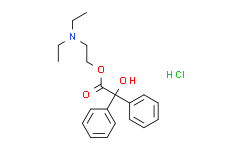| 中文名称: | 盐酸贝那替嗪 | ||||
|---|---|---|---|---|---|
| 英文名称: | Benactyzine hydrochloride | ||||
| 别名: | 2-(二乙氨基)乙基 2-羟基-2,2-二苯乙酸酯盐酸盐 2-(Diethylamino)ethyl 2-hydroxy-2,2-diphenylacetate hydrochloride | ||||
| CAS No: | 57-37-4 | 分子式: | C20H26ClNO3 | 分子量: | 363.88 |
| CAS No: | 57-37-4 | ||||
| 分子式: | C20H26ClNO3 | ||||
| 分子量: | 363.88 | ||||
| EINEC: | 200-324-4 | ||||
| EINEC: | 200-324-4 | ||||
基本信息
|
产品编号: |
B60023 |
||||
|
产品名称: |
Benactyzine hydrochloride |
||||
|
CAS: |
57-37-4 |
储存条件 |
粉末 |
室温 |
四年 |
|
|
|
||||
|
分子式: |
溶于液体 |
-80℃ |
两年 |
||
|
分子量 |
363.88 |
-20℃ |
1个月 |
||
|
化学名: |
2-(Diethylamino)ethyl 2-hydroxy-2,2-diphenylacetate hydrochloride |
||||
|
Solubility (25°C): |
|||||
|
体外:
|
DMSO |
72 mg/mL (197.86mM) |
|||
|
Water |
72 mg/mL (197.86mM) |
||||
|
Ethanol |
72 mg/mL (197.86mM) |
||||
|
体内(现配现用): |
|
||||
|
<1mg/ml表示微溶或不溶。 |
|||||
|
普西唐提供的所有化合物浓度为内部测试所得,实际溶液度可能与公布值有所偏差,属于正常的批间细微差异现象。 |
|||||
|
请根据产品在不同溶剂中的溶解度选择合适的溶剂配制储备液;⼀旦配成溶液,请分装保存,避免反复冻融造成的产品失效。 |
|||||
制备储备液
|
浓度
溶液体积 质量 |
1mg |
5mg |
10mg |
|
1mM |
2.7482mL |
13.7408mL |
27.4816mL |
|
5mM |
0.5496mL |
2.7482mL |
5.4963mL |
|
10mM |
0.2748mL |
1.3741mL |
2.7482mL |
|
50mM |
0.0550mL |
0.2748mL |
0.5496mL |
生物活性
|
产品描述 |
一种丁酰胆碱酯酶 (BChE) 抑制剂,其 Ki 值为 0.010mM。 |
|
靶点 |
Ki: 0.010mM (BChE) |
|
体外研究 |
Benactyzine hydrochloride and drofenine are widely used anticholinergic drugs which are also competitive inhibitors of BChE with Ki values of 0.010±0.001 and 0.003±0.000mM, respectively. Results indicate that the inhibition of BChE by Benactyzine hydrochloride is pure or partial competitive. Pure competitive inhibition can be distinguished from partial competitive inhibition by plotting v vs [Benactyzine] at a fixed [BTCh]. |
|
体内研究 |
Benactyzine hydrochloride (1 mg/kg) does not influence the attention response. Benactyzine hydrochloride increases the duration of the exploratory-motor reaction, but slightly diminishes the salivation elicited by acetylcholine. There is no blocking effect of Benactyzine hydrochloride and promazine on the EEG-seizure activity elicited by acetylcholine, and almost no inhibitory effect on emotional reactions. Emotional reactions are blocked by high doses of imipramine and promazine, but not by Benactyzine hydrochloride. The data indicates that imipramine, promazine and Benactyzine hydrochloride influence the autonomic effects of serotonin in different ways. Promazine, and especially Benactyzine hydrochloride, inhibit and shorten the period of salivation elicited by the intra-amygdaloid injection of serotonin . |
推荐实验方法(仅供参考)
|
Kinase Assay |
Butyrylcholinesterase activity is measured spectrophotometrically with spectrophotometer using butyrylthiocholine iodide (BTCh) as substrate. In the kinetic studies, initial velocities are measured at 37°C by using 0.25 mM 5,5’-dithio-bis(2-nitrobenzoic acid) (DTNB) in 5mM 3-(N-morpholino)propanesulfonic acid (MOPS) buffer, pH 7.5, and appropriate concentrations of Benactyzine hydrochloride and drofenine solutions prepared in water, as a function of BTCh concentration from 0.25 to 5.0 mM BTCh in 0.5 mL final volume of assay mixture (0.5mL assay mixture contains 1.56 mg purified enzyme). Assays are carried out in duplicate and activities are measured for up to 90 s |
|
Animal Administration |
Experiments are carried out in 36 cats of both sexes weighing 1.8 to 4 kg in a free-behavior situation. The experiments are carried out in the following order: after the first micro-injection of acetylcholine and/or serotonin and/or noradrenaline (200μg) into the amygdala the changes in the behavior, autonomic reactions and EEG are recorded for a period of 10 min and then followed by intramuscular injections of imipramine and/or Benactyzine hydrochloride and/or promazine and/or saline (in control experiments). The second micro-injection of neurohormones (200μg) into the amygdala is performed in 45 rain after the intramuscular injection of drugs and/or saline, and the effect is compared with the previous one, induced by the first micro-injection |
本计算器可帮助您计算出特定溶液中溶质的质量、溶液浓度和体积之间的关系,公式为:
质量 (g) = 浓度 (mol/L) x 体积 (L) x 分子量 (g/mol)
摩尔浓度计算公式
用本工具协助配置特定浓度的溶液,使用的计算公式为:
开始浓度 x 开始体积 = 最终浓度 x 最终体积
稀释公式
稀释公式一般简略地表示为:C1V1 = C2V2 ( 输入 输出 )








